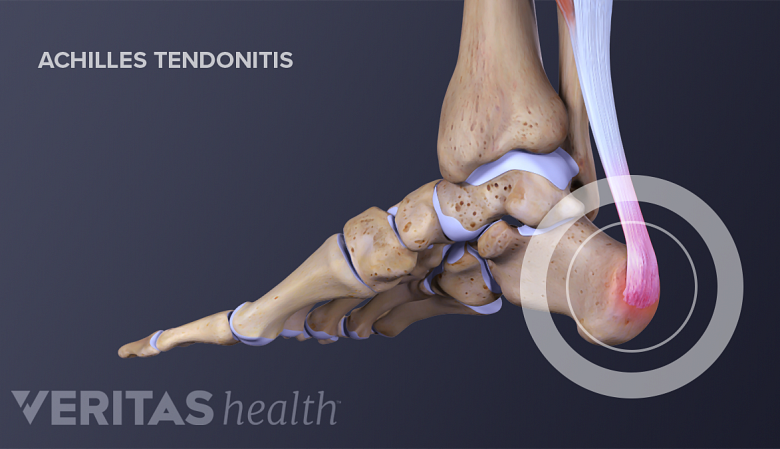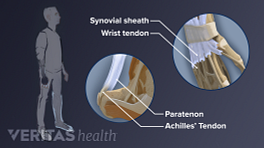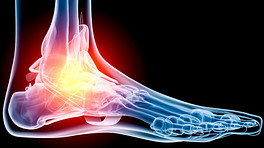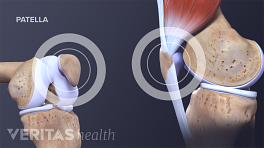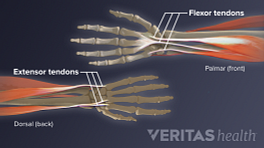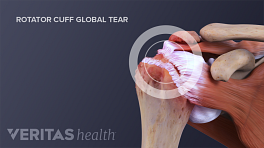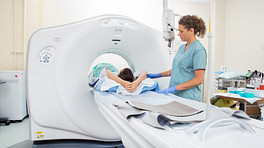What’s in a name? When it comes to an injury of the tendon, it turns out the answer may be “quite a bit.”
Doctors may use several different terms to describe tendon injuries. These terms are often confused and used interchangeably, however, each term has its own unique meaning. With regard to chronic tendon injuries, the 3 most common terms that you’re likely to hear are:
- Tendonitis. Tendonitis occurs when a tendon is irritated and/or inflamed. This inflammation usually occurs due to small (micro) tears in the tendon. 1 Bass E. Tendinopathy: why the difference between tendinitis and tendinosis matters. Int J Ther Massage Bodywork. 2012;5(1):14-7.
- Tendinosis. Tendinosis is the chronic non-inflammatory degeneration of a tendon. Tendinosis may develop as a result of chronic tendonitis or due to repetitive strain-injuries to a tendon without adequate time to heal.
- Tendinopathy. Tendinopathy is often used to describe any problem with a tendon. These problems include tendonitis and tendinosis, as well as tendon tears and inflammation of membranes around a tendon.
See What Is the Difference Between Tendonitis, Tendinosis, and Tendinopathy?
When a tendon becomes painful, it is often assumed to be tendonitis. However, research suggests tendonitis is less common than tendinosis, and tendinosis is often misdiagnosed as tendonitis. Pain from either condition is considered to be the result of nerve transmission and other chemical irritants in a tendon, and not from inflammation. 2 Sharma P, Maffulli N. Biology of tendon injury: healing, modeling and remodeling. J Musculoskelet Neuronal Interact. 2006;6(2):181-90.
Commonly Injured Tendons
The most commonly injured tendons are the shoulder’s rotator cuff tendons, which affect over 1% of the population. 3 Dean BJF, et al., Review: Emerging concepts in the pathogenesis of tendinopathy, The Surgeon (2017), http://dx.doi.org/10.1016/j.surge.2017.05.005 Other tendon areas prone to injury include the Achilles (leg), patellar (knee), elbow, and wrist.
To understand your tendinopathy, you may need to differentiate between the two most commonly confused terms – tendonitis and tendinosis.
See Chronic High (Proximal) Hamstring Tendinopathy
Tendonitis vs. Tendinosis
Both tendonitis and tendinosis can result from overuse injury, causing delayed symptoms. Tendonitis may also result from an acute, sudden force on a tendon, in which case the pain and symptoms occur suddenly.
Symptoms such as pain, swelling, stiffness, and reduced strength in the affected tendon are seen in both tendonitis and tendinosis. A few differentiating factors between tendonitis and tendinosis are described below. 4 Wilson JJ, Best TM. Common overuse tendon problems: a review and recommendations for treatment. Am Fam Phys. Sep 1 2005;72(5):811e8.
| COMPARISON FACTOR | TENDONITIS | TENDINOSIS |
|---|---|---|
| Recovery time in acute cases | 2 to 3 days | 2 to 3 months |
| Recovery time in chronic cases | 4 to 6 weeks | 3 to 6 months |
| Long-term outlook with non-surgical treatment | Almost 99% of cases recover completely | Up to 80% of cases recover completely |
| Treatment goals | Decrease inflammation by: Rest, anti-inflammatory medication (short-term course), icing the tendon intermittently, and/or use of cast or splint | Encourage formation of collagen and other proteins by: Physical therapy, exercise, and/or surgery (in some cases) |
| Long-term outlook after surgery | Almost 95% of cases recover after surgery | 70 to 85% of cases recover after surgery |
| Recovery time after surgery | 3 to 4 weeks | 4 to 6 months |
Almost all tendon injuries can be diagnosed by a medical professional with the help of a physical examination and medical imaging techniques. Ultrasound and magnetic resonance imaging (MRI) are particularly useful in viewing characteristic tendon changes in tendinopathy.
Learn more:
- 1 Bass E. Tendinopathy: why the difference between tendinitis and tendinosis matters. Int J Ther Massage Bodywork. 2012;5(1):14-7.
- 2 Sharma P, Maffulli N. Biology of tendon injury: healing, modeling and remodeling. J Musculoskelet Neuronal Interact. 2006;6(2):181-90.
- 3 Dean BJF, et al., Review: Emerging concepts in the pathogenesis of tendinopathy, The Surgeon (2017), http://dx.doi.org/10.1016/j.surge.2017.05.005
- 4 Wilson JJ, Best TM. Common overuse tendon problems: a review and recommendations for treatment. Am Fam Phys. Sep 1 2005;72(5):811e8.
